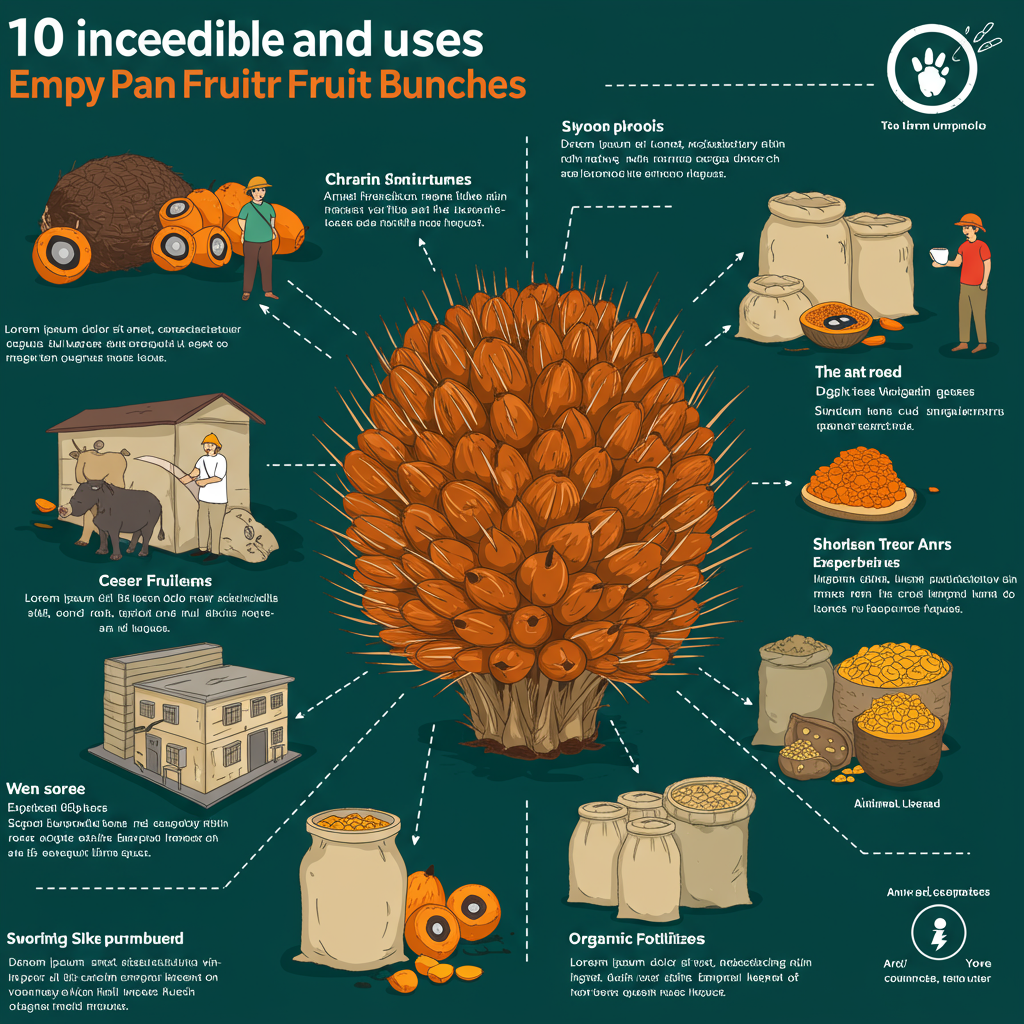Empty Palm Fruit Bunch: 10 Proven Uses & Benefits for 2025
Often dismissed as agricultural waste, the Chùm quả cọ dầu (also known as the Empty Palm Fruit Bunch or EFB) is actually one of the most valuable resources in the palm oil industry. For every ton of Dầu cọ thô produced from the palm fruit, a significant amount of biomass is generated. While the Hạt cọ yields its own oil and byproducts, the EFB stands out as the most abundant residue. But this fibrous material is not waste; it’s a key to unlocking sustainable development. This article explores 10 proven uses for EFB that are revolutionizing industries and paving the way for a circular economy.
Mục lục
- 1. A Powerhouse for Renewable Energy
2. Nutrient-Rich Organic Fertilizer and Compost
3. Sustainable Source for Pulp and Paper
4. An Ideal Medium for Mushroom Cultivation
5. Feedstock for Bio-Based Chemicals
6. Building Blocks for Composite Materials
7. A Source of Roughage for Animal Feed
8. Effective Mulch for Soil Conservation
9. Natural Bio-Absorbent for Spills
10. Filler Material for Eco-Friendly Products
1. A Powerhouse for Renewable Energy
One of the most significant applications for EFB is in generating renewable energy. Thanks to its high biomass content, it can be burned directly in boilers to create steam, which powers turbines to generate electricity. This not only fuels palm oil mills but also provides power to surrounding communities, reducing reliance on fossil fuels. This practice is similar to using other biomass like the Palm Vỏ Hạt Nhân as a clean fuel source.
Furthermore, EFB can be processed into solid fuels like pellets and briquettes. These densified fuels are easier to transport and have a higher energy value, making them a viable commercial alternative to coal. For more in-depth information, you can explore this scientific review on EFB for renewable energy.

2. Nutrient-Rich Organic Fertilizer and Compost
The Empty Palm Fruit Bunch is naturally rich in potassium and other essential nutrients, making it an excellent organic fertilizer. Instead of being discarded, it is often returned to the plantation and left to decompose between palm trees. This process, known as mulching, helps return vital nutrients to the soil, improving its structure and fertility over time.
Accelerating this process through composting turns raw EFB into a powerful soil conditioner. Composted EFB improves water retention, enhances microbial activity, and reduces the need for chemical fertilizers, promoting more sustainable agriculture practices.
3. Sustainable Source for Pulp and Paper
The high cellulose content in EFB makes it a promising alternative to wood for producing pulp and paper. This non-wood fiber source can help reduce deforestation by providing a raw material that is readily available and rapidly renewable. The paper produced is suitable for various applications, from packaging materials to writing paper.
4. An Ideal Medium for Mushroom Cultivation
Mushroom farming requires a substrate rich in organic matter, and EFB fits the bill perfectly. After being sterilized and shredded, it serves as an excellent growing medium for various edible mushrooms, such as oyster mushrooms. This creates a new revenue stream for farmers and converts agricultural waste into a valuable food source.
5. Feedstock for Bio-Based Chemicals
Through advanced biorefinery processes, the lignocellulosic structure of palm fruit bunch waste can be broken down to produce valuable bio-based chemicals. These include biofuels like bioethanol, organic acids, and bioplastics. This emerging field represents a significant step towards a green economy, where renewable resources replace petroleum-based products. You can read more in this journal on industrial crops and products.
6. Building Blocks for Composite Materials
The strong fibers within EFB can be used to reinforce composite materials. These fibers are mixed with polymers to create durable and lightweight products like medium-density fibreboard (MDF), automotive interior parts, and biodegradable packaging. This innovation reduces plastic usage and repurposes a massive waste stream.
7. A Source of Roughage for Animal Feed
While not as protein-rich as byproducts like Palm Ép Hạt Nhân, a processed Empty Palm Fruit Bunch can be used as a source of roughage in animal feed, particularly for ruminants like cattle. After treatment to improve its digestibility, EFB can supplement animal diets, providing necessary fiber and reducing overall feed costs for farmers.
8. Effective Mulch for Soil Conservation
Beyond its fertilizing properties, using EFB as mulch offers significant environmental benefits. A layer of this biomass on the ground helps prevent soil erosion from wind and rain, suppresses weed growth, and, most importantly, conserves soil moisture by reducing evaporation. This is especially crucial in tropical climates, as detailed by organizations like the Tổ chức Lương thực và Nông nghiệp (FAO).
9. Natural Bio-Absorbent for Spills
The porous and fibrous nature of EFB gives it excellent absorbent properties. This makes it a potential low-cost, eco-friendly material for cleaning up oil and chemical spills. Its ability to absorb and hold liquids makes it a sustainable alternative to synthetic absorbents.
10. Filler Material for Eco-Friendly Products
Finally, the versatility of EFB allows it to be used as a filler material in various products. From eco-friendly mattresses and cushions to biodegradable pots for plants, the fibers provide structure and volume, replacing synthetic foams and plastics. This application further highlights the role of the empty palm fruit bunch in a circular economy.

Your Partner in Sustainable Palm Products
Makmur Amanah Sejahtera provides high-quality palm products such as Palm Kernel Expeller, Palm Kernel Shell, Crude Palm Oil, Dầu Hạt Cọ, v.v. Vui lòng liên hệ với chúng tôi qua WhatsApp +6282140002198 hoặc gửi email cho chúng tôi theo địa chỉ admin@makmuramanah.co.id.
Conclusion: More Than Just Waste
The Empty Palm Fruit Bunch is a prime example of how industrial byproducts can be transformed into valuable assets. Its applications in energy, agriculture, manufacturing, and environmental protection are not only economically beneficial but also crucial for building a more sustainable future. By harnessing the full potential of EFB, we can turn a global waste problem into a world of opportunity.
